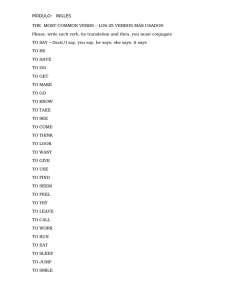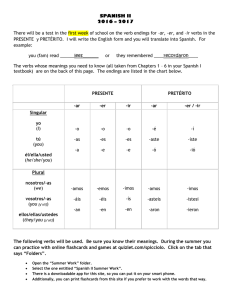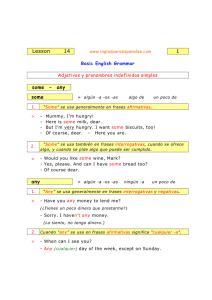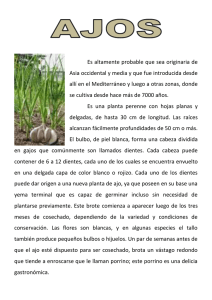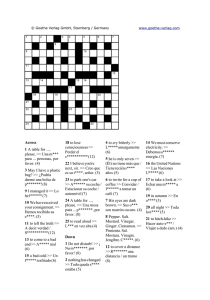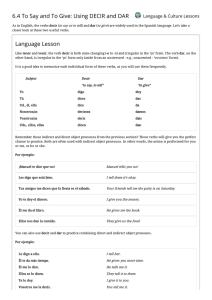Las preposiciones y los medios de transporte Las preposiciones y
Anuncio
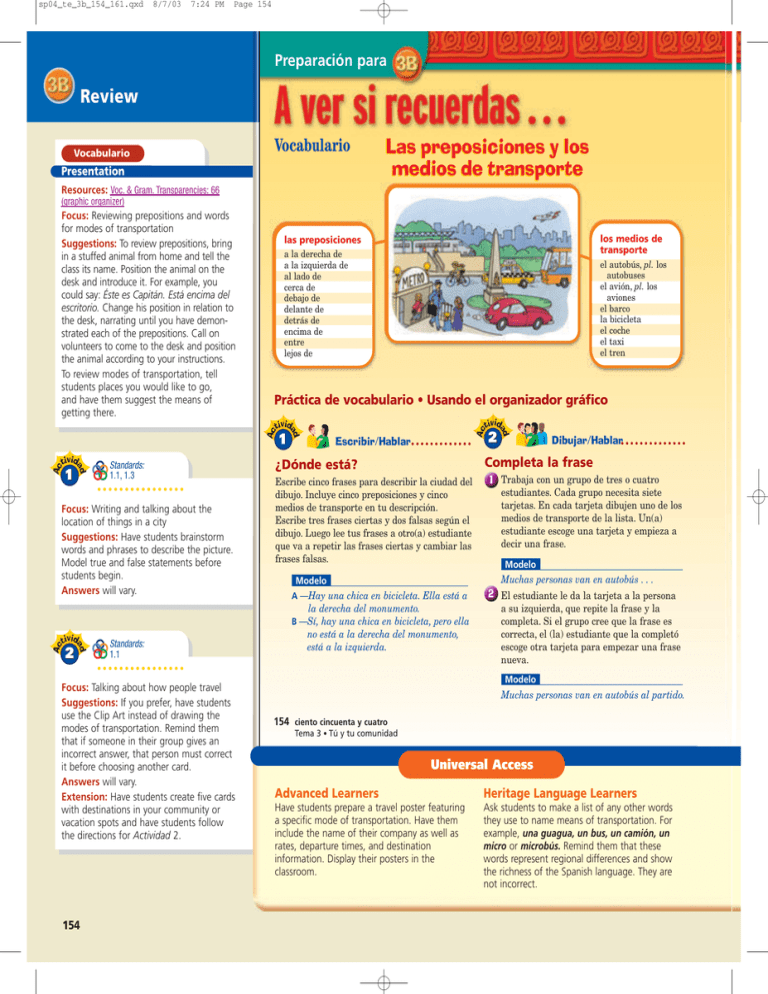
sp04_te_3b_154_161.qxd 8/7/03 7:24 PM Page 154 Preparación para Review Vocabulario Vocabulario Presentation Las preposiciones y los medios de transporte Resources: Voc. & Gram. Transparencies: 66 (graphic organizer) Focus: Reviewing prepositions and words for modes of transportation Suggestions: To review prepositions, bring in a stuffed animal from home and tell the class its name. Position the animal on the desk and introduce it. For example, you could say: Éste es Capitán. Está encima del escritorio. Change his position in relation to the desk, narrating until you have demonstrated each of the prepositions. Call on volunteers to come to the desk and position the animal according to your instructions. To review modes of transportation, tell students places you would like to go, and have them suggest the means of getting there. los medios de transporte el autobús, pl. los autobuses el avión, pl. los aviones el barco la bicicleta el coche el taxi el tren las preposiciones a la derecha de a la izquierda de al lado de cerca de debajo de delante de detrás de encima de entre lejos de Práctica de vocabulario • Usando el organizador gráfico Standards: 1.1, 1.3 •••••••••••••••• Focus: Writing and talking about the location of things in a city Suggestions: Have students brainstorm words and phrases to describe the picture. Model true and false statements before students begin. Answers will vary. Ac ad tivid 2 Standards: 1.1 Ac Ac Ac 1 ad ad tivid 1 Escribir/Hablar 154 2 Dibujar/Hablar Completa la frase ¿Dónde está? Escribe cinco frases para describir la ciudad del dibujo. Incluye cinco preposiciones y cinco medios de transporte en tu descripción. Escribe tres frases ciertas y dos falsas según el dibujo. Luego lee tus frases a otro(a) estudiante que va a repetir las frases ciertas y cambiar las frases falsas. Modelo A —Hay una chica en bicicleta. Ella está a la derecha del monumento. B —Sí, hay una chica en bicicleta, pero ella no está a la derecha del monumento, está a la izquierda. •••••••••••••••• Focus: Talking about how people travel Suggestions: If you prefer, have students use the Clip Art instead of drawing the modes of transportation. Remind them that if someone in their group gives an incorrect answer, that person must correct it before choosing another card. Answers will vary. Extension: Have students create five cards with destinations in your community or vacation spots and have students follow the directions for Actividad 2. ad tivid tivid 1 Trabaja con un grupo de tres o cuatro estudiantes. Cada grupo necesita siete tarjetas. En cada tarjeta dibujen uno de los medios de transporte de la lista. Un(a) estudiante escoge una tarjeta y empieza a decir una frase. Modelo Muchas personas van en autobús . . . 2 El estudiante le da la tarjeta a la persona a su izquierda, que repite la frase y la completa. Si el grupo cree que la frase es correcta, el (la) estudiante que la completó escoge otra tarjeta para empezar una frase nueva. Modelo Muchas personas van en autobús al partido. 154 ciento cincuenta y cuatro Tema 3 • Tú y tu comunidad Universal Access Advanced Learners Heritage Language Learners Have students prepare a travel poster featuring a specific mode of transportation. Have them include the name of their company as well as rates, departure times, and destination information. Display their posters in the classroom. Ask students to make a list of any other words they use to name means of transportation. For example, una guagua, un bus, un camión, un micro or microbús. Remind them that these words represent regional differences and show the richness of the Spanish language. They are not incorrect. sp04_te_3b_154_161.qxd 8/7/03 7:25 PM Page 155 Review The verbs salir, decir, and venir ¿Recuerdas? (yo) salgo digo vengo (nosotros) (nosotras) salimos decimos venimos (tú) sales dices vienes (vosotros) (vosotras) salís decís venís Ud. (él) (ella) sale dice viene Uds. (ellos) (ellas) salen dicen vienen You already know four -er verbs that have a yo form that ends in -go. tener: yo tengo poner: yo pongo hacer: yo hago traer: yo traigo Presentation •Note that salir is irregular only in the yo form; decir follows a pattern similar to that of e ➞ i stem-changing verbs; and venir follows a pattern similar to that of e ➞ ie stem-changing verbs. Práctica de gramática Ac Ac 4 Ac •••••••••••••••• ¿Con qué frecuencia? Enrique describe lo que pasa en la ciudad. Escribe la forma apropiada del verbo correcto para completar las frases. Escribe seis frases para decir con qué frecuencia haces las actividades del recuadro. Luego lee tus frases a otro(a) estudiante para ver si hace las mismas cosas que tú. venir a la escuela en autobús decir la verdad traer un cuaderno a clase salir de casa antes de las siete de la mañana poner los libros en una mochila hacer la tarea en casa Answers: 1. vienen 2. dicen 3. viene Modelo salir con los amigos A —Siempre salgo con mis amigos los fines de semana. ¿Y tú? B —Pues, salgo con ellos a veces. Más práctica Practice Workbook 3B-A, 3B-B ciento cincuenta y cinco Preparación: Vocabulario y gramática Resources: Practice Answers on Transparencies Focus: Reading a passage and writing present-tense forms of irregular verbs Suggestions: Point out that the subject is not stated in every sentence in the Actividad, and that verb forms may correspond to a subject mentioned in a previous sentence. 155 Enriching Your Teaching Teacher-to-Teacher Teacher-to-Teacher Have students make sock puppets and put on a puppet show in which the characters are discussing what is in their town and how they get to each place. Encourage them to use the verbs from the Gramática • Repaso. After students have practiced, have them present their shows to the class. Help students to group the verbs in the Gramática • Repaso by referring to them as the “go-go verbs.” Have an artistic student draw a picture of a traffic light on green, and write each of the verbs that end in -go in the shape of cars. This visual will help provide a good “memory hook.” tivid ad For: Review of vocabulary and grammar Visit: www.phschool.com Web Code: jdd-0311 3 Escribir/Hablar En la ciudad Muchas personas 1. ( poner / venir) a la ciudad en autobús o en tren. Ellos 2. (decir / salir) que es mejor que ir en coche. Mi primo es muy deportista. Él siempre 3. (decir / venir) a la ciudad en bicicleta y 4. (traer / salir) todas sus cosas en una mochila. 5. (Salir / Hacer) de casa muy temprano porque vive bastante lejos de la ciudad. Él 6. ( decir / traer) que es mejor montar en bicicleta porque 7. (salir / hacer) ejercicio al mismo tiempo. Mis hermanos y yo 8. ( hacer / venir) en autobús o a veces en el coche de papá. 9. (Poner / Traer) el almuerzo porque no regresamos a casa para almorzar. Standards: 1.2 ad Leer/Escribir ad ad 3 tivid tivid tivid Resources: Voc. & Gram. Transparencies: 67 Suggestions: Direct attention to the ¿Recuerdas? As you review, remind students that although all of the verbs are irregular, they do not all follow the same patterns. Before going through the Gramática • Repaso, show the transparency and have students identify the pattern of each irregular verb. Ac Salir “to leave, to go out,” decir “to say, to tell,” and venir “to come” are irregular -ir verbs. They also have a yo form that ends in -go. 4 4. trae 5. Sale 6. dice 7. hace 8. venimos 9. Traemos Standards: 1.1, 1.3 •••••••••••••••• Resources: Practice Answers on Transparencies Focus: Writing and speaking about how often activities are done Suggestions: Before beginning the activity, have students brainstorm a list of words that indicate frequency, such as nunca, siempre, todos los días, and a menudo. Answers will vary but will include: vengo, digo, traigo, salgo, pongo, and hago 155
